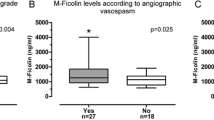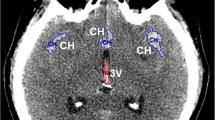Abstract
Purpose
To investigate plasma and cerebrospinal fluid (CSF) concentrations of pentraxin 3 (PTX3), a prototypic long pentraxin protein induced by proinflammatory signals, in subarachnoid hemorrhage (SAH), and its relation with SAH-associated vasospasm.
Methods
Serial plasma and CSF samples were collected from 38 consecutive SAH patients admitted to the Neurosurgical Intensive Care. PTX3 concentrations were analyzed in relation to clinical status and clinical vasospasm (defined as neuro-worsening and angiographic confirmation of vessel narrowing). Since neutrophils are an important source of preformed PTX3, myeloperoxidase (MPO) in CSF was measured to assess the correlation with CSF PTX3 and establish whether blood contamination was the determinant of PTX3 increase.
Results
PTX3 was elevated in all SAH patients both in plasma and CSF. Acute peak (first 48 h after SAH) CSF PTX3 was significantly higher in patients who later developed vasospasm [median 13.6 (range 2.3–51.9) ng/ml] compared to those who did not [3.2 (0.1–50.5) ng/ml, p = 0.03]. The temporal pattern of CSF PTX3 in patients with vasospasm was triphasic with a peak during the first 48 h after SAH, a subsequent decrease in the following 48–96 h and a secondary significant increase with the occurrence of vasospasm. A loose correlation between CSF PTX3 and MPO was observed (r 2 = 0.13), indicating that following SAH there is a brain production of PTX3.
Conclusions
Acute increased concentrations of PTX3 in CSF but not in plasma are related to the occurrence of vasospasm, indicating that measurement of CSF PTX3 associated with the clinical evaluation can improve early diagnosis of this complication.



Similar content being viewed by others
References
Cahill J, Calvert JW, Zhang JH (2006) Mechanisms of early brain injury after subarachnoid hemorrhage. J Cereb Blood Flow Metab 26:1341–1353
Citerio G, Gaini SM, Tomei G, Stocchetti N (2007) Management of 350 aneurysmal subarachnoid hemorrhages in 22 Italian neurosurgical centers. Intensive Care Med 33:1580–1586
Bederson JB, Connolly ES Jr, Batjer HH et al (2009) Guidelines for the management of aneurysmal subarachnoid hemorrhage: a statement for healthcare professionals from a special writing group of the Stroke Council, American Heart Association. Stroke 40:994–1025
Provencio JJ, Vora N (2005) Subarachnoid hemorrhage and inflammation: bench to bedside and back. Semin Neurol 25:435–444
Harrod CG, Bendok BR, Batjer HH (2005) Prediction of cerebral vasospasm in patients presenting with aneurysmal subarachnoid hemorrhage: a review. Neurosurgery 56:633–654 (discussion 633–654)
Dumont AS, Dumont RJ, Chow MM et al (2003) Cerebral vasospasm after subarachnoid hemorrhage: putative role of inflammation. Neurosurgery 53:123–133 (discussion 133–135)
Macdonald RL, Kassell NF, Mayer S et al (2008) Clazosentan to overcome neurological ischemia and infarction occurring after subarachnoid hemorrhage (CONSCIOUS-1): randomized, double-blind, placebo-controlled phase 2 dose-finding trial. Stroke 39:3015–3021
Mauri T, Bellani G, Patroniti N et al (2010) Persisting high levels of plasma pentraxin 3 over the first days after severe sepsis and septic shock onset are associated with mortality. Intensive Care Med 36:621–629
Mauri T, Coppadoro A, Bellani G et al (2008) Pentraxin 3 in acute respiratory distress syndrome: an early marker of severity. Crit Care Med 36:2302–2308
Mantovani A, Garlanda C, Bottazzi B et al (2006) The long pentraxin PTX3 in vascular pathology. Vascul Pharmacol 45:326–330
Fazzini F, Peri G, Doni A et al (2001) PTX3 in small-vessel vasculitides: an independent indicator of disease activity produced at sites of inflammation. Arthritis Rheum 44:2841–2850
Latini R, Maggioni AP, Peri G et al (2004) Prognostic significance of the long pentraxin PTX3 in acute myocardial infarction. Circulation 110:2349–2354
He X, Han B, Bai X et al (2010) PTX3 as a potential biomarker of acute lung injury: supporting evidence from animal experimentation. Intensive Care Med 36:356–364
Muller B, Peri G, Doni A et al (2001) Circulating levels of the long pentraxin PTX3 correlate with severity of infection in critically ill patients. Crit Care Med 29:1404–1407
Jaillon S, Peri G, Delneste Y et al (2007) The humoral pattern recognition receptor PTX3 is stored in neutrophil granules and localizes in extracellular traps. J Exp Med 204:793–804
Polentarutti N, Bottazzi B, Di Santo E et al (2000) Inducible expression of the long pentraxin PTX3 in the central nervous system. J Neuroimmunol 106:87–94
Introna M, Alles VV, Castellano M et al (1996) Cloning of mouse ptx3, a new member of the pentraxin gene family expressed at extrahepatic sites. Blood 87:1862–1872
Kotooka N, Inoue T, Fujimatsu D et al (2008) Pentraxin3 is a novel marker for stent-induced inflammation and neointimal thickening. Atherosclerosis 197:368–374
Zanier ER, Longhi L, Fiorini M et al (2008) Increased levels of CSF heart-type fatty acid-binding protein and tau protein after aneurysmal subarachnoid hemorrhage. Acta Neurochir Suppl 102:339–343
Zanier ER, Refai D, Zipfel GJ, et al. (2010) Neurofilament light chain levels in ventricular cerebrospinal fluid after acute aneurysmal subarachnoid haemorrhage. J Neurol Neurosurg Psychiatry (Epub ahead of print)
Fisher CM, Kistler JP, Davis JM (1980) Relation of cerebral vasospasm to subarachnoid hemorrhage visualized by computerized tomographic scanning. Neurosurgery 6:1–9
Wilson JT, Pettigrew LE, Teasdale GM (1998) Structured interviews for the Glasgow Outcome Scale and the extended Glasgow Outcome Scale: guidelines for their use. J Neurotrauma 15:573–585
Reichlin T, Socrates T, Egli P et al (2010) Use of myeloperoxidase for risk stratification in acute heart failure. Clin Chem 56:944–951
van Gijn J, Kerr RS, Rinkel GJ (2007) Subarachnoid haemorrhage. Lancet 369:306–318
Macdonald RL (2006) Management of cerebral vasospasm. Neurosurg Rev 29:179–193
Pluta RM, Hansen-Schwartz J, Dreier J et al (2009) Cerebral vasospasm following subarachnoid hemorrhage: time for a new world of thought. Neurol Res 31:151–158
Fassbender K, Hodapp B, Rossol S et al (2001) Inflammatory cytokines in subarachnoid haemorrhage: association with abnormal blood flow velocities in basal cerebral arteries. J Neurol Neurosurg Psychiatry 70:534–537
Osuka K, Suzuki Y, Tanazawa T et al (1998) Interleukin-6 and development of vasospasm after subarachnoid haemorrhage. Acta Neurochir (Wien) 140:943–951
Schoch B, Regel JP, Wichert M, Gasser T, Volbracht L, Stolke D (2007) Analysis of intrathecal interleukin-6 as a potential predictive factor for vasospasm in subarachnoid hemorrhage. Neurosurgery 60:828–836 (discussion 828–836)
Iadecola C (2009) Bleeding in the brain: killer waves of depolarization in subarachnoid bleed. Nat Med 15:1131–1132
Macdonald RL, Pluta RM, Zhang JH (2007) Cerebral vasospasm after subarachnoid hemorrhage: the emerging revolution. Nat Clin Pract Neurol 3:256–263
Acknowledgments
The Human MPO test kit was kindly provided by Hycult Biotechnology (The Netherlands). We acknowledge valuable suggestions of Dr. Vincenzo Branca and Dr. Simona Cavallo. We thank our students and nurses who participated in the study and in the care of the patients enrolled.
Author information
Authors and Affiliations
Corresponding author
Electronic supplementary material
Below is the link to the electronic supplementary material.
Rights and permissions
About this article
Cite this article
Zanier, E.R., Brandi, G., Peri, G. et al. Cerebrospinal fluid pentraxin 3 early after subarachnoid hemorrhage is associated with vasospasm. Intensive Care Med 37, 302–309 (2011). https://doi.org/10.1007/s00134-010-2075-2
Received:
Accepted:
Published:
Issue Date:
DOI: https://doi.org/10.1007/s00134-010-2075-2




